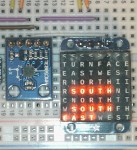 Here’s another update in my long-running digital compass project. It’s now sufficiently feature-complete to be a potentially useful end-user product. Major improvements including saving calibration data in EEPROM, improved display, error detection and temperature compensation.
Here’s another update in my long-running digital compass project. It’s now sufficiently feature-complete to be a potentially useful end-user product. Major improvements including saving calibration data in EEPROM, improved display, error detection and temperature compensation.
Read on after the break.
